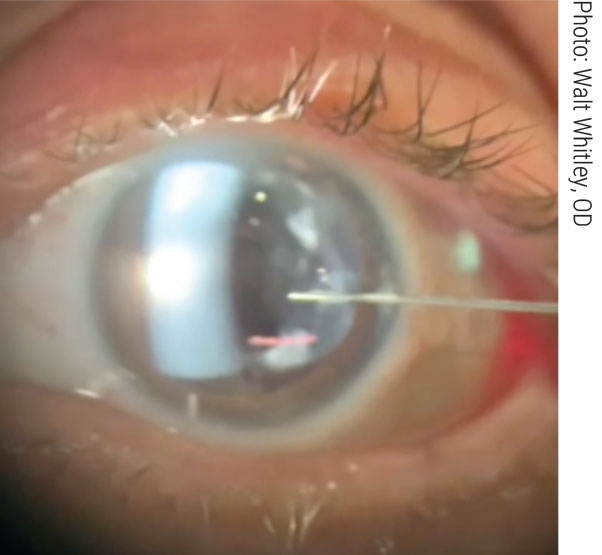 |  |
In glaucoma care, the momentum right now is with options that reduce reliance on the patient. Laser trabeculoplasty as a first-line therapy, minimally invasive glaucoma surgery at the time of cataract surgery and combination drugs that put two or more agents in one bottle all aim to achieve IOP control in a patient-friendly way, recognizing this group’s struggles with adherence. The newest idea—intracameral sustained-release of medication—is now upon us. Durysta (Allergan) is an injectable pellet of 10mcg bimatoprost that delivers a small amount of drug in the anterior chamber that lasts up to 15 weeks in clinical studies, though the effect on IOP is said to extend beyond that. Other intracameral injections currently being studied will follow in time.
Nonetheless, we now have a novel drug delivery device that has shown efficacy in lowering IOP while having an excellent safety profile. Below we discuss what optometrists need to know when comanaging Durysta with our surgical colleagues.
 |
Durysta delivers bimatoprost into a patient’s anterior chamber. Click image to enlarge. |
Choosing the Ideal Patient
Practitioners should thoroughly evaluate the anterior chamber structures for suitability. In pseudophakes, the IOL should cover the capsulotomy and the posterior capsule should be intact. Durysta can be used in patients with pigmentary dispersion or pseudoexfoliation, but one must ensure integrity of the lens.1 Contraindications include active or suspected ocular or periocular infections, history of intraocular inflammation, endothelial cell dystrophy, prior corneal transplantation, absent or ruptured posterior lens capsule and prostaglandin allergy.1
Gonioscopy prior to insertion should ensure there is enough space in the angle to fit the implant to avoid contact with the corneal endothelium. Using the Shaffer grading system, an angle of grade 3 or 4 should allow sufficient space for implantation. Extreme caution should be used in those with narrow angles or anatomical scarring.2
Implanting the Device
Intracameral implants can be injected under topical anesthesia either at the slit lamp or in an operating room.2 Using a clear corneal paracentesis entry—typically temporal—the 28-gauge needle/injector is inserted in the anterior chamber, aimed inferiorly and the implant is injected.2 Then, the injector is slowly removed and the insertion site is tamponaded with a cotton-tip applicator.2
Most surgeons won’t prescribe an antibiotic following implantation as there is little evidence they make a difference in preventing endophthalmitis. Patients are typically seen a week later and, if recovering well, will follow-up in two to three months. The implant biodegrades over time.
Potential Adverse Reactions
Adverse reactions include hypersensitivity, corneal complications (e.g., edema, endothelial cell loss), macular edema, intraocular inflammation, pigmentation and endophthalmitis.1 Conjunctival hyperemia, seen in 27% of patients, was the most common reported ocular adverse reaction in clinical trials.1 Others noted include foreign body sensation, eye pain, photophobia, conjunctival hemorrhage, blurred vision, irritation and dry eye.3 Headaches were the most common non-ocular adverse reaction.3
Though questions remain about the feasibility of—and insurance coverage for—repeat injections after the initial implant dissolves, even a short-term break from meds is welcome. With a reported 32% drop in IOP, Durysta expands treatment options for glaucoma patients, especially those who may be hypersensitive and/or have poor compliance or ocular surface disease.3
Dr. Zimmerman is an ocular disease resident at Dell Laser Consultants in Austin, TX. He has no financial disclosures.
Dr. Cunningham is the director of optometry at Dell Laser Consultants in Austin, TX. He has no financial interests to disclose. Dr. Whitley is the director of professional relations and residency program supervisor at Virginia Eye Consultants in Norfolk, VA. He is a consultant for Alcon.
Dr. Schiffbauer practices at Virginia Eye Consultants in Norfolk, VA. She is a consultant for Bausch + Lomb and a speaker for Eyevance Pharmaceuticals.
1. Craven ER. Tips and tricks for Durysta injection. www.glaucomaphysician.net/issues/2020/september-2020/tips-and-tricks-for-durysta-injection. September 1, 2020. Accessed September 16, 2021.
2. Okeke C. Simple steps for successful Durysta implant insertion. [Video]. YouTube. www.youtube.com/watch?v=Byfj_5Fsi6U. May 19, 2021. Accessed September 16, 2021.
3. Durysta (bimatoprost implant). www.durystahcp.com. Accessed September 16, 2021.

